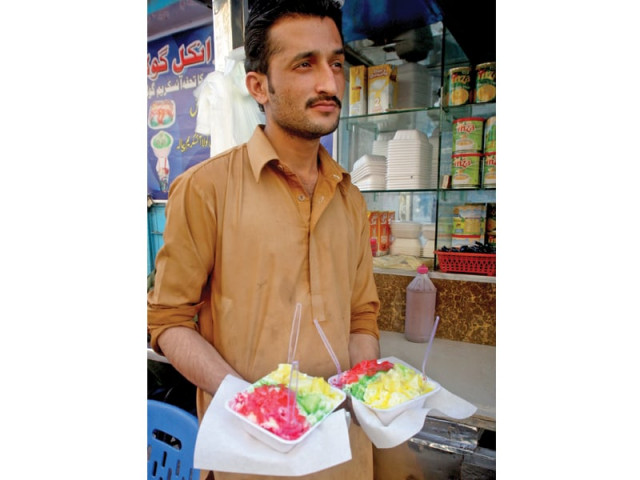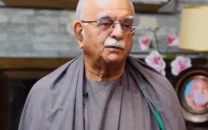Ice, ice baby: Don't keep calm, you can't have a gola ganda
Unhealthy ingredients lead to a ban in Sukkur; praised by adults, bemoaned by children.

"Vendors are using textile colours instead of permitted food colours since they are much cheaper," A former gola ganda wallah, Shakeel Ahmed.
As soon as summer arrives, vendors of gola ganda [snow cone], kulfi and ice cream take to the streets, delighting young and old alike as they provide a reprieve from the summer heat.
The gola ganda is especially popular among children, who are attracted to the brightly coloured syrups that are poured on the shaved ice balls. Prices as low as Rs5 for a small cup make the deal all the more sweet.

However, they have now been banned throughout Sukkur by the district administration. Their reason; the ice is made from contaminated water and the syrup from substandard sweeteners and colours.
Snow cones
The vendors, commonly referred to as gola ganda wallah, are often seen outside schools and slums, where students and the poor find delight in the sweet syrupy treat.
Muhammad Yasin has been selling gola ganda for the past 15 years and he claims that he uses good quality sweeteners and colours for preparing the syrup, but did concede that he is forced to use contaminated water as he does not have any other choice.
“I use sugar and quality food colours to prepare the syrup because most of my customers are children,” he said. “We use different colours to attract them. The same sweeteners are used in all the syrups, only the colours are changed.”
Yasin was aware of the consequences of using contaminated water and said that he tries to use clean water whenever it is available but that is not always possible.
Another gola ganda wallah, Shakeel Ahmed, now sells fruit and was critical of those selling gola ganda. “Their only concern is money,” he said. “The health hazards to customers are the least of their worries.”

He then went on to talk about how it hadn’t always been like this. “My father used to sell gola ganda in the late seventies and he used to prepare his syrups using only high quality sweeteners and food colours,” he recalled. “Now, vendors are using textile colours instead of permitted food colours since they are much cheaper.”
However, he blamed the district administration for not having quality checks on consumer items, which according to him is allowing people to do whatever they want.
Why the administration says no
Sukkur deputy commissioner Shahzad Tahir Thaheem confirmed the ban on gola ganda sale and said that the ban is due to the stomach diseases that the gola ganda can cause.
“Firstly, gola ganda is made from ice that contains contaminated water, which is hazardous to health,” he said. “The vendors also tend to use substandard sweeteners and colours to prepare the syrups and we cannot allow them to put our children at risk. We will also be launching a campaign against the ice factories themselves.”
Health hazard
The Pakistan Medical Association’s Sindh chapter joint secretary Dr Usman Mako told The Express Tribune that contaminated ice and water are the main causes of stomach diseases. He said that since the days are hot and the nights are comparatively cooler, the use of ice during this particular season can often lead to different health problems.

The Sukkur District Health Officer Dr Abdul Karim Baloch welcomed the ban on the sale of gola ganda and, like the others, also said that the use of contaminated ice and substandard syrups is dangerous for children. He added that most of the edible items sold by vendors are adulterated. “Continuous use of such items has weakened our immune system, especially of our children,” he said. “This particular weather is very dangerous because people start using ice and cold drinks to avoid the heat and that can lead to a multitude of health problems.”
Published in The Express Tribune, April 29th, 2014.



















COMMENTS
Comments are moderated and generally will be posted if they are on-topic and not abusive.
For more information, please see our Comments FAQ